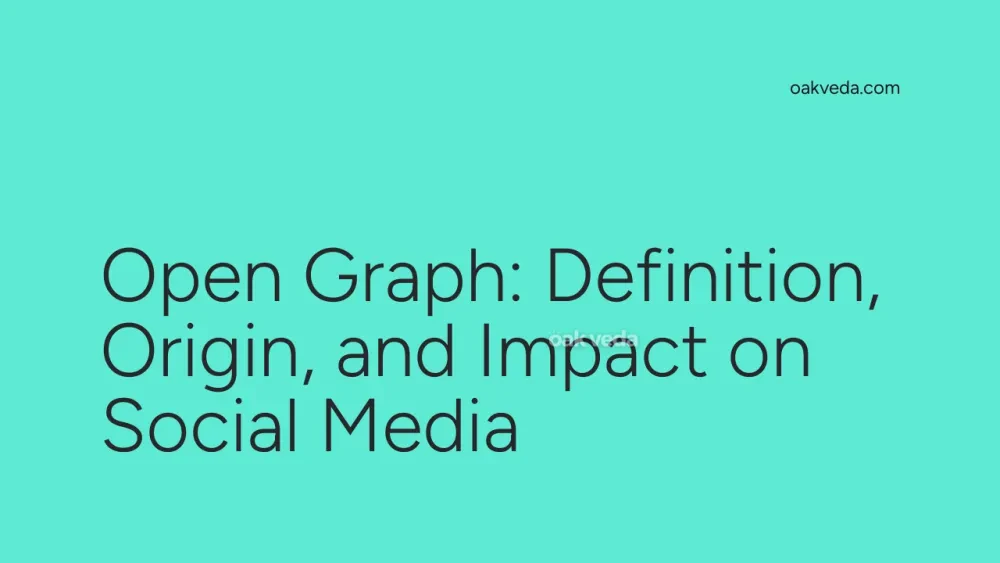
What is Open Graph?
Open Graph is a powerful protocol developed by Facebook that revolutionizes how web content is shared and displayed on social media platforms. It allows website owners and developers to control the presentation of their content when shared across various social networks, ensuring a visually appealing and informative preview.
Origin and Development of Open Graph
Introduced by Facebook in 2010, Open Graph was initially designed to integrate external websites with the Facebook platform. However, its utility quickly expanded beyond Facebook, gaining widespread adoption across numerous social media networks. The protocol has since evolved, with regular updates enhancing its capabilities and adapting to the changing landscape of social media sharing.
How Open Graph Works
Open Graph functions through the implementation of meta tags in a webpage's HTML code. These tags provide structured data that social media platforms can interpret and use to generate rich previews when the content is shared. The key components of Open Graph include:
- Title: Defines the headline for the shared content
- Description: Provides a brief summary of the page content
- Image: Specifies the thumbnail image to be displayed
- URL: Indicates the canonical URL for the shared page
When a user shares a link on social media, the platform's crawler reads these Open Graph tags and uses the information to create an optimized preview, enhancing the content's visibility and appeal.
Types of Open Graph Tags
While the basic Open Graph tags cover essential information, there are several specialized tags for different content types:
- og:type: Specifies the type of content (e.g., article, video, product)
- og:site_name: Indicates the overall site name
- og:video: Used for sharing video content
- og:audio: Implemented for audio content sharing
Popular Examples of Open Graph Implementation
Many major websites and platforms have embraced Open Graph to enhance their social media presence:
- E-commerce sites: Amazon uses Open Graph to display product details when items are shared.
- News outlets: The New York Times implements Open Graph for article previews on social media.
- Streaming services: Netflix utilizes Open Graph to showcase movie and TV show information.
Impact of Open Graph on Social Media Culture
Open Graph has significantly influenced social media culture by:
- Enhancing visual appeal: Rich previews make shared content more attractive and clickable.
- Improving user experience: Users can quickly understand shared content without leaving their social media feed.
- Increasing engagement: Well-crafted Open Graph implementations can boost click-through rates and social interactions.
- Standardizing content presentation: Open Graph has created a consistent way of displaying shared content across platforms.
How Brands and Influencers Use Open Graph
Savvy marketers and content creators leverage Open Graph to:
- Optimize social media campaigns: By crafting compelling titles, descriptions, and images for shared content.
- Increase brand visibility: Ensuring brand logos and key visuals appear in social media previews.
- Drive traffic: Creating enticing previews that encourage users to click through to the full content.
- Control messaging: Maintaining consistent brand messaging across various social platforms.
Future Trends Related to Open Graph
As social media continues to evolve, Open Graph is likely to adapt and expand:
- Integration with emerging platforms: As new social networks emerge, Open Graph may be adopted or adapted to suit their needs.
- Enhanced multimedia support: Improved handling of video, audio, and interactive content previews.
- AI-driven optimization: Machine learning algorithms may help optimize Open Graph tags for maximum engagement.
- Privacy considerations: As data privacy concerns grow, Open Graph may evolve to balance information sharing with user privacy.
FAQs about Open Graph
-
Is Open Graph only for Facebook? No, while Facebook developed it, Open Graph is now supported by many social media platforms, including LinkedIn, Twitter, and Pinterest.
-
Do I need to be a developer to implement Open Graph? Basic implementation can be done by adding meta tags to your HTML. However, for more advanced usage, some development knowledge may be helpful.
-
Can Open Graph improve my website's SEO? While Open Graph primarily affects social media sharing, it can indirectly impact SEO by increasing engagement and traffic to your site.
-
How can I test my Open Graph implementation? Facebook provides a Sharing Debugger tool that allows you to preview and troubleshoot your Open Graph tags.
-
Are there any alternatives to Open Graph? Twitter Cards is a similar protocol specifically for Twitter, while Schema.org provides more general structured data markup.
Open Graph has become an integral part of the social media ecosystem, shaping how content is shared and consumed across platforms. By providing a standardized way to control content previews, it empowers website owners, marketers, and developers to optimize their social media presence. As the digital landscape continues to evolve, Open Graph is likely to remain a crucial tool for enhancing content visibility and engagement in the social media sphere.
You may be interested in:

